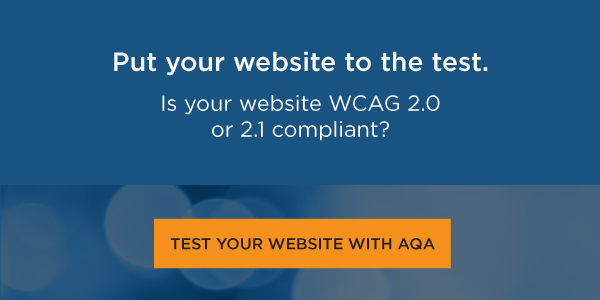Is your website accessible? Having an accessible website is incredibly important because it ensures you can reach everyone who wants to access your information, regardless of any disabilities.
Your website is an important source of information about your business. It’s the first stop for many potential customers who search for you online, and it contains valuable information that answers the basic questions about your business before a customer ever interacts directly with you.
The 2005 enactment of the Accessibility for Ontarians with Disabilities Act (AODA) requires business owners to comply with new regulations that raise and enforce the standards of accessibility in Ontario. AODA applies to five specific areas:
● Customer service
● Employment
● Design of public spaces
● Information and communication
● Transportation
AODA’s goal is to make each of these areas fully accessible by 2025. This far-reaching act is applicable to nearly all privately- and publicly-owned organizations in Ontario that are regulated by the province.
Upcoming Deadlines for the AODA Act
Public-sector organizations affected by AODA were required to file reports that confirmed their compliance by December 31, 2019. Two more important deadlines are on the horizon, and those are:
● December 31, 2020: Nonprofit and privately-owned organizations with 20 or more employees must also have their compliance reports filed.
● January 1, 2021: Every website, app, and all digital content that goes live online after January 1, 2020, is required to meet a specific set of standards: W3’s Web Content Accessibility Guidelines (WCAG) 2.0. These guidelines must be met at the AA level, with the exception of criteria 1.2.4 and 1.2.5 (live captioning and audio descriptions that have been pre-recorded, respectively).
Who needs accessible websites and online content?
There are a number of people who need accessible websites and online content due to a variety of disabilities and challenges. These include:
● Cognitive and learning disabilities
● Epileptic seizures
● Hearing impairment or deafness
● Impaired speech
● Mental illness
● Physical disabilities and mobility challenges, such as amputation, coordination or balance difficulties, or paralysis
● Traumatic brain injury
● Visual impairment or blindness
● Those who use devices such as a wheelchair, cane, or walker to aid them with mobility
● People who use service pets to help them manage their condition
● Mental health challenges
● Impaired cognition
AODA is meant to help all persons in Ontario experience the full advantages of the information and resources available to them online and in public. These standards of accessibility cultivate empathy and help organizations break down barriers to inclusion.
What is WCAG 2.0?
WCAG stands for Web Content Accessibility Guidelines. The 2.0 version of the guidelines was developed to help individuals with disabilities to access websites and the information they contain, regardless of their ability.
For AODA, websites must comply with WCAG 2.0, which means they need to meet 12 accessibility standards. WCAG 2.0 is the most widely-accepted, worldwide standard for laws relating to web accessibility. It’s the primary point of reference in settlements and legal cases related to ADA accessibility.
WCAG 2.0 requires organizations to offer their users alternative ways to access online content when it’s not possible or practical to update the original web site. Under WCAG, all websites must be perceivable, operable, understandable, and robust.
WCAG 2.0 requires websites to be operated by any person with a disability. All online content must be able to be seen, heard, perceived, and understood by any person with impaired vision, hearing, or cognition.
Now, let’s talk about what you need to make your website both accessible and AODA-compliant. Whatever the size of your business--whether publicly or privately-owned--these standard regulations apply to you.
Formats that are accessible
In order to make your data fully accessible, your business should be able to provide either electronic or printed documents on request that are usable by persons with disabilities. You must also make sure your web site visitors know these formats and supports are available to them.
There are a number of accessible formats for web sites and digital content. These may include accessible audio formats, Braille, enlarged print, HTML, Microsoft Word, and written transcripts of both audio and visual data.
Support for communication
All modes of communication on your website must also be made accessible in order to comply with AODA. These forms of support may include:
● Audio descriptions
● Closed captions
● Devices that speak to the user (text-to-speech)
● Having an assistant or note-taker available to aid in communications
● Handwritten note exchanges on request
● Listening assistance
● Picture, word, or letter boards
● Sign language--and interpretation of sign language
● Sign language intervention
● Willingness to read your information to a disabled individual
● Willingness to repeat information, make information clearer, and restate the same information
Exceptions to AODA
Some exceptions to AODA exist, and include:
● Any online content published to the web prior to January 1, 2012
● Any scenario in which it’s not practical to comply with AODA, depending on the ability to adapt the existing information to be compliant
● Descriptive audio in videos that are either pre-recorded or captured live
● Information that can’t be converted (i.e., a weather radar map)
● Live video captions
● Third party-managed online content
● Sites on an intranet
Conclusion
When you work to make your website AODA-compliant, you’re really opening your busines to a whole new world of individuals who may otherwise miss out on what you have to offer. With the right information, support, and tools to navigate this process, you can have a fully-accessible website that any user may utilize.
Not sure whether your website is compliant? Test it now.







